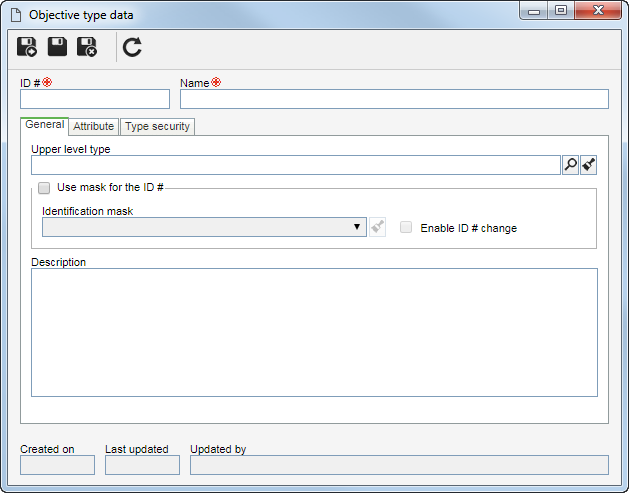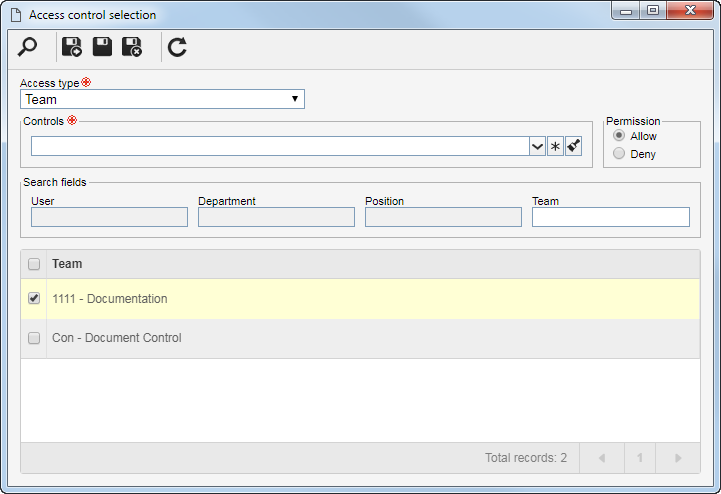|
To configure an objective type, in the main screen toolbar, click on the  button. button.
On the type data screen, enter an ID # and a name for the record.

Save the record. At this point, the following tabs will be available to be configured:
Field
|
Upper level type
|
Select the objective type that, in the type hierarchy, is one level above the record in question. This field is filled out by the system if an objective type is selected in the type hierarchy on the main screen.
|
Use mask for the ID #
|
Check this option so that when creating objectives of this type, the automatic identification resource is used. Fill in the following fields:
▪Identification mask: Select the desired identification mask. Note that only identification masks whose object is "Objective" will be available for selection. ▪Enable generated ID # change: Check this option to allow the generated ID # to be edited manually when creating an objective in this type. If this option is not checked, the generated ID # may not be edited. |
Description
|
Use this field to enter relevant descriptions referring to the objects of this type.
|
|
Use this tab to define attributes to complement the information of the objectives of this type. On the side toolbar, the following buttons are also available:

|
Click on this button to associate an attribute that was previously created in the system with the type. Refer to the Adding attributes section for further details on how to perform this operation.
|

|
Click on this button to save the association of attributes with the control.
|

|
Click on this button to disassociate the attribute selected in the list of records from the record.
|
If the attribute configurations are edited (e.g.: an attribute checked as required becomes non-required or vice versa), they will be replicated to the records of this type when their data is edited.
|
|
Use this tab to configure the security of the objective type. To do that, at the top of this tab, select one of the following options:
Public: Select this option for any user of the SE Risk to have access to the type.
Restricted: Select this option for only specific users of the SE Risk to have access to the type in question. At this point, the sidebar buttons will be enabled. Click on the  button and fill out the fields on the screen that will be opened: button and fill out the fields on the screen that will be opened:

i.
|
In the Access type field, select one of the following options to set the access type that will compose the security list:
▪Team: It will be composed of the members of a team previously created in SE Risk. ▪Department: It will be composed of users from a selected department. ▪Department/Position: It will be composed of users from a specific department of the company, who have a specific position. ▪Position: It will be composed of users who hold specific position in the company. ▪User: It will be composed of a specific user. ▪All: It will be composed of all users who have access to the SE Risk component.
|
ii.
|
In the Controls field, it is possible to select the actions that may or may not be performed in the type. To do so, select the controls that will be granted to access the type selected previously:
▪Add: Adds new types to levels below the control type. ▪Edit: Changes the data of the type. ▪Delete: Deletes the type. ▪Security data: Edits the security data of the type. Users who have this control denied, or not enabled, may edit the other data of the objective type; however, this tab will be blocked. ▪List: Allows viewing the type on the system screens that display the objective type hierarchy. Users who have this control denied, or not enabled, will not see the objective type in the type hierarchy. ▪View: Views the data screen of the type.
Use the buttons located next to the field to expand and view the list of controls, mark all available controls, and clear the markups you have made.
|
|
iii.
|
Select in the Permission field, if the controls checked previously will be granted or denied for access type.
|
iv.
|
According to selected access type, Filters will be enabled to be filled out. Use them to facilitate the search of users who will form the security list.
|
v.
|
 After that, click on the After that, click on the  button on the toolbar of the selection screen. Depending on the access type selected and the values entered in the filters, the result will be displayed in the list of records, located at the bottom of the screen. Select the ones that will compose the security list and save the record. Hold the SHIFT or CTRL keys down or check next to each item to select more than one record at a time. button on the toolbar of the selection screen. Depending on the access type selected and the values entered in the filters, the result will be displayed in the list of records, located at the bottom of the screen. Select the ones that will compose the security list and save the record. Hold the SHIFT or CTRL keys down or check next to each item to select more than one record at a time.
|
|
After filling in the necessary fields, save the record.
|







